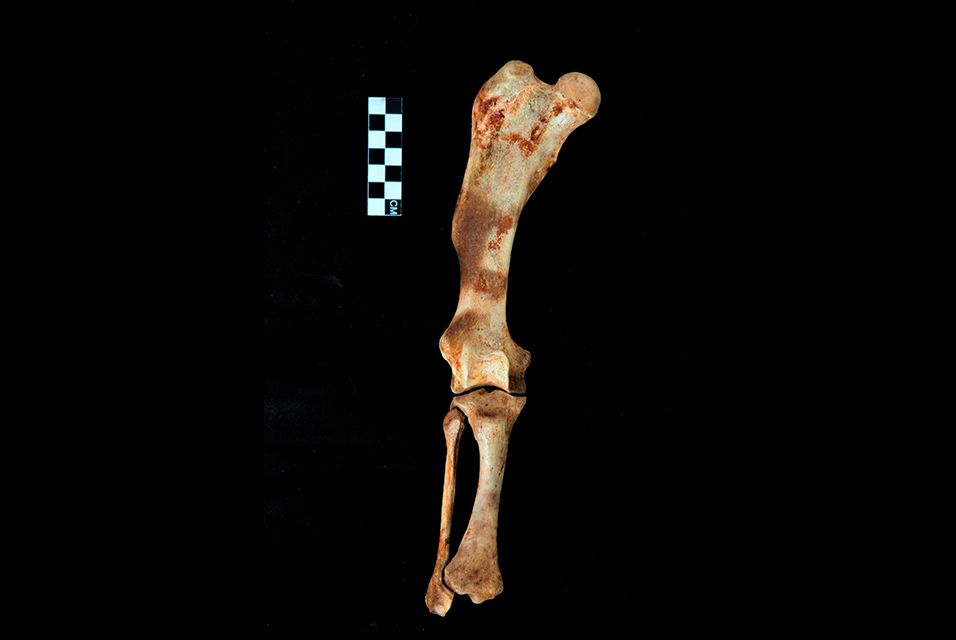BALTIMORE, MD.- Scientists at
Johns Hopkins Medicine and the Philadelphia College of Osteopathic Medicine report new evidence that some 5,000 years ago, a sloth smaller than a black bear roamed the forest floor of what is now the Dominican Republic in the Caribbean Sea, living a lowland life different from its cousins on the other side of the island. The newly identified mammalian species—now extinct—was smaller and had anatomical differences in its forelimb that gave it greater range of motion, possibly to help the animal occupy more lowland areas than its tree-dwelling kin.
The evidence was uncovered initially in January 2009, when divers found the sloth's bones in a flooded cave on the island of Hispaniola, now home to the Dominican Republic and Haiti. After extensive study of the partial skeleton and bones from several other specimens, the scientists have concluded it is a previously unknown species of ground sloth, which they dubbed Parocnus dominicanus.
The scientists say the discovery is important: "It allows us to explain variation in the fossil record," says Siobáhn Cooke, Ph.D., assistant professor of functional anatomy and evolution at the Johns Hopkins University School of Medicine. "If we're trying to reconstruct an animal's life, we need to understand their relationships, anatomy and habitat." No sloths live on the island today, although fossil evidence shows they were the largest mammal there at the very end of the 2.5-million-year Stone Age.
The researchers' findings were published in Vertebrate Anatomy Morphology Palaeontology.
Cooke notes that the two- and three-toed, tree-dwelling sloths found in today's forests of Central and South America are smaller than the diverse group of sloths that existed 5,000 years ago. The ancient precursors to modern sloths migrated as far north as parts of present-day North America, some species as large as elephants, faster and semiaquatic, like otters living part of the time in the sea and on land.
"I'm biased, but I think sloths are wonderful animals," says Robert McAfee, Ph.D., associate professor of anatomy at the Philadelphia College of Osteopathic Medicine. "They are an underappreciated species, with unique adaptations to live in a variety of habitats," he adds. "Some 80 types of sloths have existed across 50 million years, and we're left with just two species today."
On Hispaniola, scientists previously found six or seven species of ancient sloths.
Evidence of the new addition, says Cooke, was found in a now flooded but once dry cave, called Padre Nuestro, on the eastern tip of the Dominican Republic. To explore the cave, the scientists collaborated with diving experts who specialize in navigating water-filled cave environments.
The scientists don't know if the sloths fell into the cave or crawled in and could not escape.
Compared with the first-identified species of sloth on the island, P. dominicanus was about 10% to 15% smaller in all measurements of the discovered bones. The scientists also found that the location where deltoid muscles attached to the forelimb was different from previously identified species P. browni and P. serus.
The difference in the muscle attachments placed the muscles in a different position, potentially providing a greater range of motion, strength and ability to manipulate its forearms, a potential advantage for walking on its forearms in more lowland habitats rather than climbing and hanging upside down in trees, hallmarks of modern sloths.
To solidify their belief that P. dominicanus was a new species, they studied fossil records of ancient and extinct sloths found across Caribbean islands. The new bone specimens, they say, were consistently smaller. "We accounted for some level of size variation due to male/female size differences, but overall, P. dominicanus was much smaller," says Cooke.
Sloths disappeared from the Caribbean about 4,000 years ago, and humans arrived about 5,000–6,000 years ago. So, people and sloths coexisted in the region for about 1,000 years, say the researchers. It's not clear, they say, whether sloths were widely hunted on the islands or if they disappeared due to human-spurred change in the habitat.
Funding for the expedition and research was provided by 2015 Ernst Mayr Travel Grants in Animal Systematics from Harvard's Museum of Comparative Zoology.
In addition to Cooke and McAfee, other contributors to the research included Sophia M. Beery from Ohio University, Renato Rímoli from the Museo del Hombre Dominicano, Dominican Republic, Juan Almonte from the Museo Nacional de Historia Natural, Dominican Republic, and Phillip Lehman from the Dominican Republic Speleological Society.









